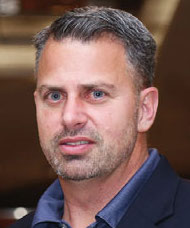Technology
People Power
Technology is only as smart and helpful as the humans who created it.
- Travis MacMillian
- August 2018
-






Machine learning technology advances such as chatbots, virtual assistants and driver safety apps are transforming the insurance industry. They not only help to lower insurers' risks but provide customer service to policyholders. All this technology is created from insurers' technology infrastructures.
In the insurance industry, “infrastructure” is typically defined as the systems architecture on which a company's hardware and software conduct core enterprise and ancillary business functions. But as the lines between technology and operations continue to blur, that definition seems increasingly narrow. It suggests the brain power, the intellectual capital that informs every transaction and every decision shouldn't be considered part of every company's infrastructure. Is that accurate? Is it fair? I don't think so. Let me explain why.
The Big Picture
With attention increasingly being paid to artificial intelligence (AI), robotic process automation (RPA), and machine learning—and with disciplines like strategic operations support (SOS) coming to the fore in pursuit of insurers' target operating models—one fundamental truth needs to be borne in mind: Everything run by AI, every automated bot, and every machine, the memory of which creates the illusion of learning, has to be developed, programmed and configured by a human being.
So, with that truth in mind, we all need to remember:
• AI might connect dots to simulate the appearance of creativity. But it doesn't create.
• Bots might perform repetitive activities as if they know all the subtasks within a given activity. But they don't improvise.
• Machines might appear to have learned from having conducted particular tasks or transactions. But they don't know anything they haven't done before.
Once we accept the truth of those realizations, we're on our way to broadening our understanding of the concept of infrastructure.

Travis MacMillian
All the technology in the world won’t replace people. In fact, it can’t, since it’s impossible for technology to exist without them.
The Real Picture
Science fiction is chock-full of dystopian tales of robotic contraptions and artificial intelligence run amok. Consider just two: Isaac Asimov's I, Robot examines the relationships between humans, robots and morality, in particular the aberrant behavior of robots caused by their positronic brains. Likewise, in Arthur C. Clarke's 2001: A Space Odyssey, the spaceship's onboard computer, the HAL 9000, concocts a story about the ship's communication unit (the AE-35) to lure one of the crew, Dr. Frank Poole, to his death. Thereafter, HAL kills three other crew members by asphyxiation and forces the sole survivor, Dr. David Bowman, to complete the ship's mission alone. Bowman is then transformed into an immortal Star Child, returns to Earth and detonates an orbiting nuclear warhead. Nice.
Is it possible that AI tools or embodiments like robots and HAL contain electrons that fire randomly, inexplicably, and chaotically, causing them to commit nefarious deeds without rational cause or provocation? Sure it is. Anything may be possible. Is it likely? Not so much. It's more likely that any aberrant behavior or undesirable consequences are attributable to the people who programmed those tools or embodiments.
In the insurance industry, the promises of hardware, software, AI, RPA, and machine learning are fantastic. Their applications, changing the way we operate as an industry, are becoming more than dreams. And with so many technological advancements and the quick development of our never-ending capabilities, we'll all achieve much. But there's no “infra” in infrastructure without people and their intellectual contributions. With the efficiencies enabled by strategic operations support, organizations will find more important, strategic roles for their people to play in the adoption of process-centric improvements and the evolution of their target operating models.
Technology doesn't invent or improve itself. People do. Technology doesn't generate and amass intellectual capital. People do. Infrastructures don't create themselves and their own structural, functional logic. People do. And that's the reality in all of the promises of hardware, software, AI, RPA, and machine learning. As a result, as technology evolves and becomes more adaptable to processes, insurers will be able to find ways for their people to contribute more fruitfully.
The Prioritized Picture
At this point, the notion of The Three P's—people, process, and product—has become a cliché. But all clichés contain kernels of truth. And there's nothing truer than the fact that people are your most important resources, whether they're salaried or contract, in-house or outsourced.
In his 1967 poem, All Watched Over by Machines of Loving Grace, Richard Brautigan imagined an idyllic utopia in which people and machines coexisted peacefully and protectively as depicted in the following stanza: “I like to think (and the sooner the better!) of a cybernetic meadow where mammals and computers live together in mutually programming harmony like pure water touching clear sky.”
I like to think so, too. But as individual companies or an insurance industry, we're not there yet. And some of us may never be. Until we get there, and even when we are there, we'll have to rely on our people—on each other—leveraging technology through the intellectual aptitudes of our people to achieve what we need to achieve, in the insurance industry and everywhere else.
In fact, the 1960s slogan, “Power to the people,” could be re-cast as “power in the people.” All the technology in the world won't replace people. In fact, it can't, since it's impossible for technology to exist without them. The most important component of infrastructure is people.
People first. Always people first.
Best’s Review contributor Travis MacMillian is chief business officer at Xceedance, a global insurance consultancy. He may be reached at bestreviewcomment@ambest.com.



























